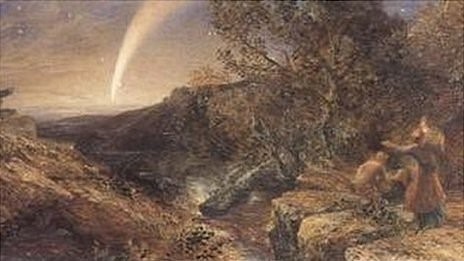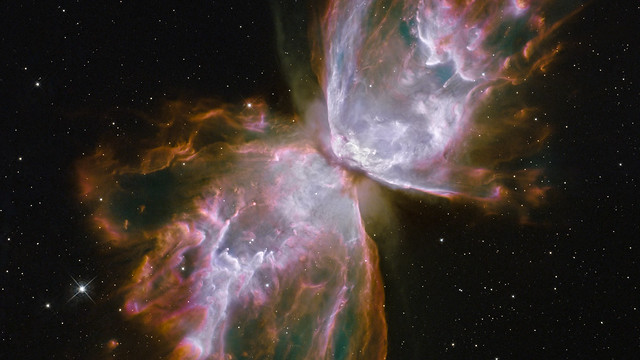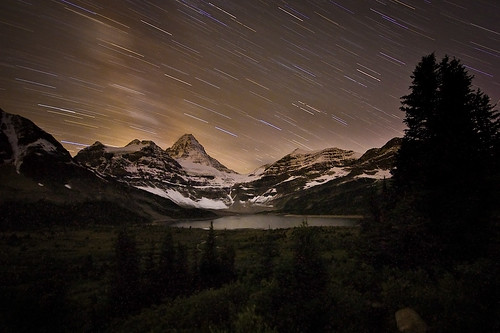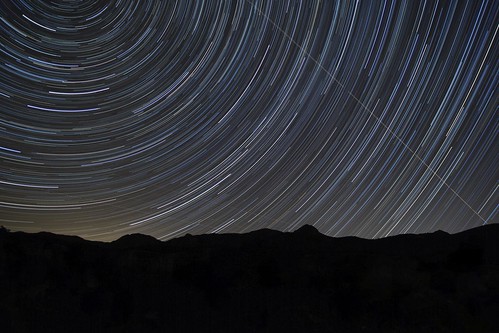Space and astronomy has inspired artists for centuries. The concept of space and its infiniteness creates feelings of curiosity and mysteriousness. Several types of art has been developed over the years with the sky as the main subject. For instance, one work of British painter Samuel Palmer, The Comet of 1858, features the phenomenon over the Dartmoor, England.
Samuel Palmer's The Comet of 1858
Humans look up and see billions of stars dotting the night sky. This magnificent view has been a muse for many works of art. For example, around Pollepel Island in the Hudson River in New York, artist Melissa McGill has created her own 'stars'. The public installation, Constellation, is arranged around the ruins of Bannerman's Castle and consists of seventeen LED lights. Every two hours, these lights, which are on poles of varying heights, are illuminated to make the image of a constellation. McGill explains her project, "the shape formed by the points of light in Constellation referred to missing architectural elements of Bannerman Castle and to a Lenape cultural belief in a celestial “white road” equivalent to the Milky Way" (Loos). She considers her work a "powerful symbol of absence and presence", which, in my opinion, also represents the theme of space.
Melissa McGill's art installation, Constellation
Another example of art inspired by the cosmos is the breathtaking photographs of astronomical bodies. Today's powerful telescopes, including NASA’s Chandra X-Ray Observatory, the Hubble Space Telescope, the Spitzer Space Telescope, and more, allow scientists and artists alike to view deep into outer space. Some objects in space are so many light-years away that they may have expired by the time the image returns to our eyes. Thus, images of space provide an interesting take on the life and death of extraterrestrial bodies.
The Aesthetics & Astronomy project at the Harvard-Smithsonian Center for Astrophysics is run by a team of astronomy experts and artists. Its aim is to analyze the photographs and ultimately determine how scientific and artistic viewpoints affect how the data is processed. According to the center's website, "aesthetics from a psychological perspective is the study of all things beautiful whether art or not, and all things art whether beautiful or not".
Butterfly Emerges from Stellar Demise in Planetary Nebula NGC 6302, taken by the Hubble Space Telescope in 2009
Finally, I would like to touch on another type of photography. These artists do not use telescopes to see extraterrestrial bodies up close; instead, they use their cameras to capture the sky from a human's perspective. Today's cameras have the ability to adjust how long the shutter remains open in order to capture more light in the image. This technique, called 'long exposure', leads to amazing works of art in which the light's path can be seen in a long streak.
Jeff Pang's Assiniboine Star Light, taken in 2010 at Lake Magog, Mount Assiniboine Provincial Park, B.C., Canada
Dan Eckert's Trona Star Stack, taken in 2010 in Trona, California
Zach Dischner's Shelfstars, taken in 2010 in Canon City, Colorado
The night sky holds so much inspiration for works of art. There are also many ways for the artist to express his or her works due to the many technologies available today. The universe is a vast space with planets, stars, and galaxies; however, it also contains so much of the unknown. It only makes sense that such a topic causes people to contemplate, thus making it the perfect topic for the blend of art and science.
Bibliography
Sources
"Astronomy & the Arts." Seeing in the Dark. Seeing in the Dark, 2008. Web. 23 July 2016.
Felsenthal, Julia. "Artist Melissa McGill’s Constellation Brings the Stars Down to Earth." Vogue. Condé Nast, 29 June 2015. Web. 23 July 2016.
Fusco, Jack. "How To: Plan Your Night Photography for Perfect Star Trails." Popular Photography. Bonnier Corporation, 12 Aug. 2014. Web. 23 July 2016.
Loos, Ted. "A 'Constellation' of Light Above the Ruins of Bannerman Castle." The New York Times. The New York Times Company, 24 June 2015. Web. 23 July 2016.
O'Donnell, Christopher. "How to Photograph Star Trails: The Ultimate Guide." Light Stalking. Light Stalking Photography Blog and Community, 10 July 2015. Web. 23 July 2016.
"Studying Perceptions of Astronomy Images." Aesthetics & Astronomy. Harvard-Smithsonian Center for Astrophysics, n.d. Web. 23 July 2016.
Images
Constellation. Melissa McGill, n.d. Web. 23 July 2016.
McCouat, Philip. "Comets in Art." Journal of Art in Society. Wordpress, 2014. Web. 23 July 2016.
"Picture Album." HubbleSite. Space Telescope Science Institute, n.d. Web. 23 July 2016.
"Star Trails: 21 Terrestrial Views of Space by Amateur Photographers." Light Stalking. Light Stalking Photography Blog and Community, 10 Nov. 2009. Web. 23 July 2016.






I loved your discussion of photography as it relates to space. The images were absolutely beautiful, and you gave concise but informative explanations of the science and the art behind each image. I also liked how you tied in aesthetics and perspective to this post, through a quick quote. Great post!
ReplyDelete